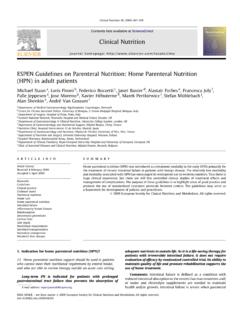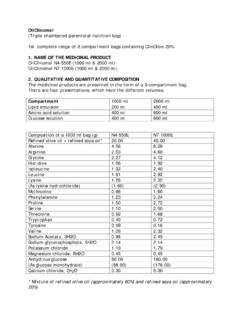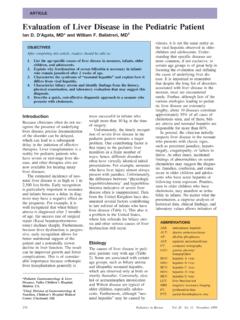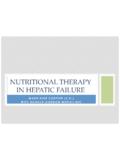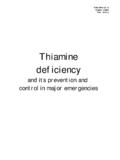Transcription of Name of the Medicine - Baxter Healthcare
1 SYNTHAMIN Product Information name of the Medicine Synthamin (Amino Acid) Intravenous Infusions with Electrolytes and Synthamin (Amino Acid). Intravenous Infusion without Electrolytes. Description Synthamin Intravenous Infusions are sterile, nonpyrogenic, hypertonic, clear and colourless to slightly yellow solutions of essential and non-essential L-amino acids provided with or without electrolytes. Synthamin Intravenous Infusions are available in , 8% and 10% strengths, each in 500 mL units for intravenous administration. Each strength has a pH of approximately and each 500 mL unit contains amino acids and nitrogen in the following quantities: 8% 10%.
2 Amino Acids g 40 g 50 g Nitrogen g g g Each 1000 mL of Synthamin Intravenous Infusions without electrolytes contains: 8% 10%. L-Amino Acids 55 g 80 g 100 g Total Nitrogen g g g Approximate pH Protein Equivalents g g 103 g Essential Amino Acids 8% 10%. L-Leucine g g g L-Phenylalanine g g g L-Methionine g g g L-Lysine (added as the hydrochloride salt) g g g L-Isoleucine g g g L-Valine g g g L-Histidine g g g L-Threonine g g g L-Tryptophan 990 mg g g Nonessential Amino Acids 8% 10%. L-Alanine g g g Aminoacetic Acid (L-Glycine) g g g L-Arginine g g g L-Proline g g L-Tyrosine 220 mg 320 mg 400 mg L-Serine g g g Approximately mmol/L sodium metabisulphite is added as stabiliser.
3 Synthamin PI (ccsi42520130305) 13 Feb2014 Page 1 of 10 SYNTHAMIN Product Information In addition to the above, Synthamin Intravenous Infusions with Electrolytes contain in each 1000 mL: Electrolytes 8% 10%. Sodium Acetate, g g g Dibasic Potassium Phosphate g g g Sodium Chloride, g g g Magnesium Chloride, g g g Synthamin Intravenous Infusions with Electrolytes contain the following non-nitrogenous ionic profile. Ions Millimoles/litre 8% 10%. Sodium 73 73 73. Potassium 60 60 60. Magnesium 5 5 5. Acetate* 100 130 150. Chloride 70 62 70.
4 2. - 30 30 30. Phosphate (as HPO4 ). * Acetate is added as sodium acetate and as acetic acid used for pH adjustment. Synthamin Intravenous Infusions without Electrolytes contain the following anion profile. Ions Millimoles/litre 8% 10%. Acetate * 45 66 82. Chloride + 22 32 40. *. Derived from pH adjustment with acetic acid +. Contributed by the L-Lysine Hydrochloride Hypertonic approx. milliosmoles/litre Synthamin 9 ( ) Intravenous Infusion with Electrolytes 820. Synthamin 9 ( ) Intravenous Infusion without Electrolytes 550.
5 Synthamin 13 (8%) Intravenous Infusion with Electrolytes 1060. Synthamin 13 (8%) Intravenous Infusion without Electrolytes 800. Synthamin 17 (10%) Intravenous Infusion with Electrolytes 1260. Synthamin 17 (10%) Intravenous Infusion without Electrolytes 1000. Synthamin PI (ccsi42520130305) 13 Feb2014 Page 2 of 10 SYNTHAMIN Product Information Pharmacology Synthamin Intravenous Infusions provide a biologically utilisable source material for protein synthesis when administered with adequate calories such as concentrated carbohydrate solutions, vitamins and minerals.
6 This mixture provides (with the exception of essential fatty acids and trace elements) adequate parenteral nutrition . Indications Synthamin Intravenous Infusions are indicated as an adjunct in the prevention of net nitrogen loss or in the treatment of negative nitrogen balance in patients where: (1) the alimentary tract, by the oral, gastrostomy or jejunostomy route, cannot or should not be used, (2) gastrointestinal absorption of protein is impaired, or (3) metabolic requirements for protein are substantially increased, as with extensive burns.
7 Contraindications 1. Patients with renal failure - anuria (for Synthamin Intravenous Infusions with Electrolytes, only). 2. Patients with clinically significant elevation of plasma concentrations of sodium, potassium, magnesium and/or phosphorus (for Synthamin Intravenous Infusions with Electrolytes, only). 3. Patients with severe liver disease - hepatic coma. 4. Patients with a congenital abnormality of amino acid metabolism. 5. Known hypersensitivity to one or more amino acids, any other active or excipient. Precautions 1.
8 Do not administer unless solution is clear. This solution should not be administered simultaneously with blood through the same infusion set because of the possibility of pseudoagglutination. 2. Proper administration of Synthamin Intravenous Infusions requires a knowledge of fluid and electrolyte balance and nutrition , as well as clinical expertise in recognition and treatment of the complications which may occur. Severe water and electrolyte disorders, severe fluid overload states, and severe metabolic disorders should be corrected before starting the infusion.
9 Frequent clinical evaluation and laboratory determinations appropriate to the patient's clinical situation and condition are necessary for proper monitoring during administration. Studies should include blood and urine glucose, serum proteins, kidney and liver function tests, water and serum electrolytes, haemogram and carbon dioxide combining power or content, acid/base balance, serum and urine osmolarities, blood cultures and blood ammonia levels. 3. Metabolic complications may occur if the nutrient intake is not adapted to the patient's requirements, or the metabolic capacity of any given dietary component is not accurately assessed.
10 It is essential to provide adequate calories concurrently if parenterally administered amino acids are to be retained by the body and utilised for protein synthesis. Concentrated glucose solutions are an effective source of such calories. Adverse metabolic effects may arise from administration of inadequate or excessive nutrients, or from inappropriate composition of an admixture for a particular patient's needs. Synthamin PI (ccsi42520130305) 13 Feb2014 Page 3 of 10 SYNTHAMIN Product Information 4. With the administration of Synthamin 9 ( ) Intravenous Infusions in combination with highly concentrated glucose solutions, hyperglycaemia, glycosuria and hyperosmolar syndrome may result.
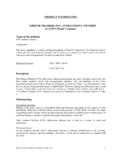
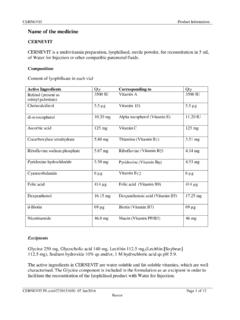
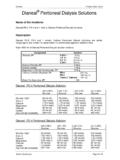
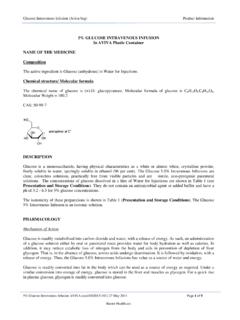
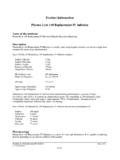
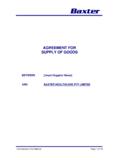
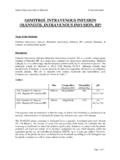
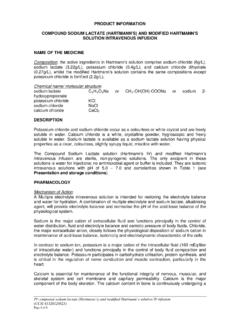
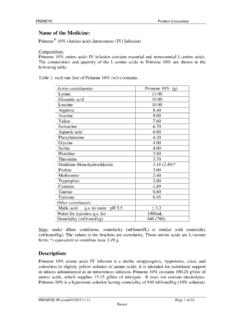
![T I S S E E L [Fibrin Sealant] - Baxter Healthcare](/cache/preview/5/e/c/8/3/b/b/2/thumb-5ec83bb2d349410260af6c556ae67fe3.jpg)
